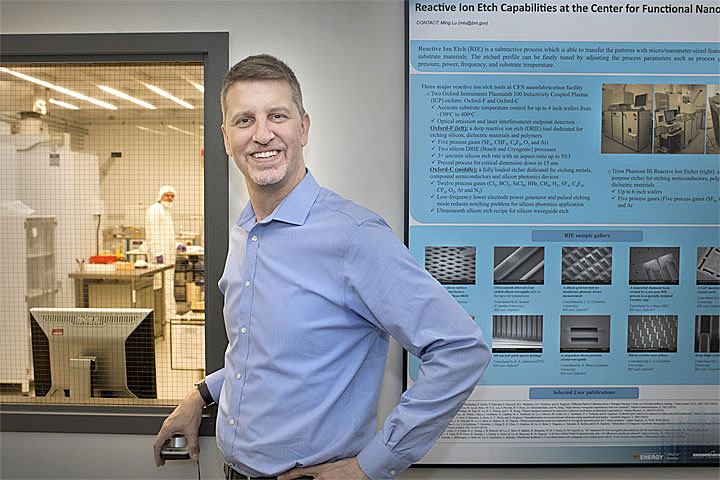A Message from Chuck Black
insights from the CFN Director
August 27, 2019

Chuck Black
Summertime is such an excellent time of year. The combination of nice weather and school vacations brings a special vibe to the season, which I find both relaxing and invigorating at once. When summer comes around each year, I am renewed in my enthusiasm for many things, including nanoscience. Each summer at the CFN, we welcome a larger number of users, as well as a group of summer interns, who provide excitement and energy for our staff as they mentor young researchers just beginning their careers.
I was reminded of the importance of continuing to have fresh perspectives on science, and on life in general, by a story I recently listened to on the radio: http://freakonomics.com/podcast/kobi-rebroadcast/.
Although at first the story seems like it’s just entertainment, as I listened on, I realized that it was actually more meaningful than that. I’ve been thinking about it ever since. And so, for this summertime newsletter, I thought it would be fun to share the story, and my thoughts about it.
The story begins in 2001 on Coney Island, New York—not far from the CFN—where for more than 50 years, the Fourth of July celebration has included the nation’s largest and most prestigious hot dog eating contest. Held outside the Nathan’s Famous Hot Dogs stand near the Coney Island boardwalk, the contest challenges contestants to eat as many hot dogs with buns as they can in 12 minutes. At that time, the contest had been held for more than 40 years, and the record number of hot dogs (with buns) anyone had eaten was 25—about one every 30 seconds!
That year, there was a new contestant: Takeru Kobayashi from Japan. Kobayashi was 23 years old and weighed only 135 pounds.
When the contest started, it quickly became clear that Kobayashi was going to win, and by a lot. He ate hot dogs in a way that no one had ever eaten them before. He took the dog out of its bun, folded it in half, and put it entirely into his mouth at once. He next soaked the bun in water, squashed it up into a tight, dense ball, and ate it in the same way. He was faster at eating hot dogs than anyone had ever seen. Even several other contestants stopped their eating mid-contest to watch Kobayashi and marvel at him. When the contest ended, Kobayashi had shattered the world record. He had eaten 50 hot dogs in 12 minutes—twice as many as anyone had ever done in the contest’s history.
How did Kobayashi do it? How was he so much better than everyone else? Why did he decide to eat hot dogs in a different way?
Years later in a radio interview, Kobayashi answered these questions. For me, this part of the story is the most interesting. According to Kobayashi, he didn’t break the world record by magically eating more hot dogs than everyone else. He did it by taking a new perspective and rethinking the entire approach to a 40-year-old problem.
In realizing that every contestant before him had been looking at the problem incorrectly, Kobayashi reasoned that maybe the world record of 25 hot dogs wasn’t any real limit at all. Even though no one had been able to surpass it, perhaps he could.
Kobayashi said “The thing about human beings is that they make a limit in their mind of what their potential is. They decide, “I’ve been told this, or this is what society tells me,” or they’ve been made to believe something. If every human being actually threw away those thoughts … the potential of human beings is really great.”
For hot dog eating, it turns out that Kobayashi was exactly right in understanding how perceived barriers can hold us back. Once he showed it was possible to overcome the perceived limit, other contestants very soon followed his example. Others who had previously only been able to eat 15 hot dogs in 12 minutes began routinely eating 30 to 40. Some of them did it by adopting Kobayashi’s approach; some simply came to the realization that they were capable of doing more. All of them benefitted from Kobayashi showing them that the old limit wasn’t a limit at all.
So far, I’ve only been talking about eating hot dogs. But in a larger sense, the lesson offered by Kobayashi relates to nearly everything in life—including nanoscience.
One of the most aspirational parts of nanoscience research is exploring the ultimate limits on the properties of materials. In nanoscience, we design and make materials, and then probe them to see how they behave. And most importantly, we have the opportunity to understand new ways by which materials can be designed to go beyond their perceived limits.
This task is incredibly exciting, but also challenging. It requires all of our skills, determination, and creativity. And even more, the task requires us to be audacious and to be unconstrained by what we think the limits are.
Throughout history, human beings have a remarkable track record at achieving the “impossible”—not only in science but also in many other areas. It turns out that when people are pressed to put their full attention to solving a challenging problem, they can do unbelievable things. This summer, I am reminded that we—our staff and users—should bring this approach to all science done at the CFN. Let’s keep taking hard looks at the limits of what materials can do, and considering whether these limits are real or perceived. Together, we may find new ways to do things that were once thought impossible.
— Chuck Black
CFN Director
2019-16751 | INT/EXT | Newsroom









